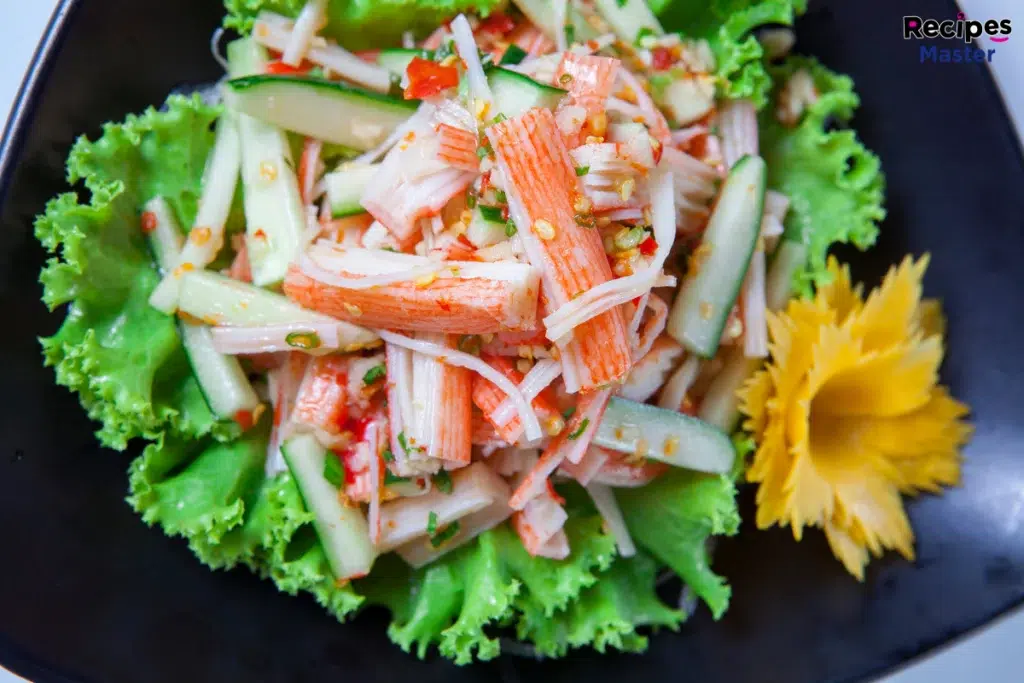
Delving into the culinary world brings us to the fascinating subject of Kani Kama, a key ingredient that has captivated food enthusiasts and chefs alike. This versatile component, often celebrated for its role in transforming the landscape of Japanese cuisine, particularly in the realm of sushi, merits a closer examination. Kani Kama, with its unique blend of taste and tradition, offers a gateway to understanding not just a food item, but a cultural phenomenon that bridges the gap between authenticity and innovation. As we explore the essence of Surimi, we embark on a journey that reveals its intricate production process, nutritional benefits, and the myriad ways it enriches our culinary experiences. This introduction serves as your guide to unlocking the secrets of Surimi, ensuring that from the very beginning, the topic of our exploration is crystal clear and inviting.
Understanding Kani Kama: A Culinary Marvel
Introduction
often celebrated as the ocean’s versatile jewel, is a testament to culinary innovation. But, what is this popular ingredient that has captivated sushi lovers and food enthusiasts alike?
Defining Kani Kama
Surimi refers to imitation crab meat, made with care from Surimi. This white fish paste, primarily from Alaskan pollock, undergoes transformation. It’s deboned, ground, seasoned, and sometimes colored to mimic crab meat’s appearance and taste. This journey from simple fish paste to a beloved staple worldwide tells a tale of creativity and adaptation.
Origins and Traditions
The inception of Crab sticks, deeply rooted in Japanese tradition, marks a fascinating chapter in culinary history. It represents more than a food item; it’s a bridge between cultures, offering a piece of Japanese heritage to the world.
The Craft
Ingredients and Method
At its core, Surimi defines Kani Kama’s essence. This paste is not just fish; it’s a blend of ingredients like crab extract that enriches its flavor. The transformation process, from deboning to shaping, mirrors the artistry behind Kani Kama.
Versatility in Forms
Surimi shines in its adaptability. Whether shredded, flaked, or cubed, its ability to blend into dishes showcases culinary flexibility. This adaptability speaks to the ingenuity inherent in food innovation.
Continuing from where we left off, let’s delve deeper into the nutritional aspects and culinary versatility , highlighting its benefits and the creativity it brings to the table.
The Essence of Kani Kama
Health and Nutrition: Analyzing
Nutritional Benefits
Despite its synthetic origin, Kani Kama emerges as a beacon of health. It’s astonishingly low in fat and cholesterol, making it a heart-friendly option. Moreover, a serving packs less than 1 gram of fat and only 17 milligrams of cholesterol. Additionally, it’s a low-calorie choice, with about 81 calories per 3-ounce serving, primarily from added carbohydrates. Thus, Kani Kama fits seamlessly into a low-cholesterol, low-fat diet, aiding those on a journey toward weight loss.
Considerations and Dietary Restrictions
However, it’s not without its caveats. Kani Kama harbors a significant amount of sodium, with a 3-ounce serving containing 715 milligrams. This figure nudges us closer to the daily maximum limit, signaling caution for those monitoring their salt intake. Awareness of this nutritional profile enables informed choices, ensuring Kani Kama enhances your diet without undermining health goals.
Culinary Creativity
Traditional and Modern Uses
Kani Kama stands as a chameleon in the culinary world. Traditionally embraced in sushi rolls and salads, its sweet, mild flavor and versatility have paved the way for innovation. From the classic California roll to avant-garde fusion dishes, Crab sticks adapts, proving its worth beyond traditional confines. This adaptability not only showcases its culinary potential but also reflects the evolving nature of global cuisine.
DIY Recipes and Ideas
The real magic of Surimi, however, lies in its home kitchen appeal. With a few simple ingredients, one can transform Kani Kama into a gourmet experience. Imagine a Kani Kama salad with crisp greens and a tangy dressing or a hearty Imitation crab meat chowder. These dishes illustrate the ease with which Surimi can elevate everyday meals, offering a taste of sophistication with minimal effort.
Continuing from our exploration into the nutritional virtues and culinary prowess of Crab sticks, let’s further unravel this culinary marvel’s distinct characteristics and how it stands in comparison to its natural counterpart.
Kani Kama vs. Real Crab: A Culinary Comparison
Diving into the heart of the matter, one might wonder how Imitation crab meat stacks up against real crab meat. This comparison not only illuminates the unique qualities of Crab sticks but also offers insights into its widespread popularity.
Taste and Texture
First and foremost, the taste and texture of Kani Kama are crafted to mimic that of real crab, albeit with subtle differences. While Kani Kama boasts a mild and somewhat sweet flavor profile, real crab meat offers a richer, more nuanced taste. The texture of Surimi, smooth and consistent due to its processed nature, contrasts with the flaky, tender fibers of genuine crab. Consequently, Imitation crab meat provides a palatable alternative for those seeking the essence of crab without the expense or hassle.
Cost-Effectiveness
Moreover, the appeal of Kani Kama extends to its cost-effectiveness. Significantly more affordable than real crab, Crab sticks enables culinary enthusiasts to enjoy the luxury of seafood flavors without stretching their budgets. This affordability, coupled with its long shelf life, makes Surimi a practical choice for both home cooks and professional chefs alike.
Culinary Flexibility
Furthermore, Kani Kama shines in its culinary flexibility. Ideal for a vast array of dishes, from salads to sushi rolls, it adapts effortlessly to both cold and hot preparations. This versatility is a boon, allowing for creative culinary expressions that might otherwise be constrained by the cost or availability of real crab.
Embarking further on our culinary voyage, we delve into the intriguing world of FAQs surrounding Kani Kama. This segment aims to shed light on common curiosities and misconceptions, providing clarity and enhancing your gastronomic knowledge.
Frequently Asked Questions
Navigating through the sea of inquiries, several questions frequently bubble to the surface regarding Kani Kama. Let’s address these queries, armed with insights and facts.
Is Kani Kama Gluten-Free?
A prevalent question concerns whether Kani Kama meets the criteria for a gluten-free diet. Due to the inclusion of wheat starch in many brands, Surimi often contains gluten. However, for those adhering to a gluten-free lifestyle, it’s worth noting that certain manufacturers offer gluten-free versions. Always scrutinize labels to ensure compatibility with dietary needs.
Can Pregnant Women Safely Consume Imitation crab meat?
Another point of discussion revolves around the safety of Kani Kama consumption during pregnancy. Given its low mercury content, Crab sticks generally poses no significant risk. Nevertheless, due to its high sodium levels, moderation is key. Consulting with a healthcare provider is advisable to tailor dietary choices to individual health profiles.
Should Kani Kama Be Heated Before Eating?
Many wonder whether Kani Kama requires heating before consumption. Interestingly, Crab sticks is pre-cooked, making it safe to eat straight from the package. Whether incorporated into cold dishes or warmed slightly for hot recipes, Surimi remains a versatile ingredient. However, to preserve its delicate flavor and texture, avoid excessive heating.
Are There Vegan Alternatives ?
For those exploring plant-based diets, the question of vegan alternatives arises. Innovative options include jackfruit, known for its meaty texture, and marinated mushrooms or tofu, offering similar versatility. These alternatives echo the essence of Kani Kama, ensuring inclusivity in culinary adventures.
Acknowledging the need for enhanced readability through better subheading distribution, let’s refine the Frequently Asked Questions section about Kani Kama with additional subheadings for clarity and ease of reading.
Frequently Asked Questions
Diving into the sea of inquiries surrounding Kani Kama, we aim to shed light on some of the most common questions. This effort not only satisfies curiosity but also deepens our appreciation for this culinary favorite.
Is Kani Kama Gluten-Free?
A pressing concern for those with dietary restrictions is whether Kani Kama meets their gluten-free needs. Unfortunately, due to the inclusion of wheat starch in its composition, Imitation crab meat is not gluten-free. This detail is essential for individuals with gluten sensitivities or celiac disease, emphasizing the importance of vigilant label reading.
Safety of Kani Kama During Pregnancy
The safety of consuming Crab sticks during pregnancy often arises as a significant concern. Given its low mercury content, Imitation crab meat is generally deemed safe for pregnant women in moderation. However, the high sodium content warrants cautious consumption. Consulting a healthcare provider is advisable to ensure that dietary choices align with a healthy pregnancy regimen.
Heating Kani Kama: Necessary or Not?
Curiosity about whether Imitation crab meat requires heating before consumption is common. Designed for direct consumption from the package, Kani Kama does not necessitate cooking. Nevertheless, for those preferring a warm meal or with food safety concerns, lightly heating Crab sticks can enhance its flavor while ensuring it remains safe to eat.
Exploring Vegan Alternatives
For vegans and vegetarians, finding suitable alternatives that align with their dietary preferences is a quest. Thankfully, food innovation has introduced options like jackfruit, smoky tofu, marinated mushrooms, and savory seitan, all capable of mimicking Kani Kama’s texture and taste. These alternatives open up a world of culinary possibilities for plant-based diets, inviting creativity in the kitchen.
Conclusion
In closing, Kani Kama stands not just as a culinary substitute but as a beacon of innovation, sustainability, and global cuisine connection. Through our journey from its origins to its place in the kitchen today, we’ve seen how Imitation crab meat transcends simple imitation, embodying the spirit of culinary creativity and cultural appreciation. It invites us to explore, innovate, and appreciate the diversity of flavors and traditions that enrich our world.
When exploring the world of Imitation crab meat, dive deeper into the culinary journey with articles such as “Top Imitation Crab Recipes: Delicious & Easy Seafood Dishes”, which showcases a variety of ways to incorporate Kani Kama into your meals. Discover “What is the Best Way to Eat Imitation Crab Meat?” for expert tips on enjoying this versatile ingredient. Further your knowledge with “What Does Kani Mean in Sushi?”, offering insights into its role in Japanese cuisine. For those curious about the specifics, “What is Kani Made Of?” delves into the composition and production process of Kani Kama. Lastly, for cooking tips, check out “Can You Cook Imitation Crab?”, providing valuable advice for preparing Kani Kama dishes at home.
Kani Kama, with its unique blend of taste, nutrition, and versatility, continues to inspire food lovers around the globe. Whether you’re a seasoned chef or a curious home cook, embracing Kani Kama opens up a world of possibilities, encouraging us to think creatively and cook with an open heart. Let’s continue to celebrate the shared human endeavor to create, enjoy, and respect the diverse tapestry of global cuisine.
